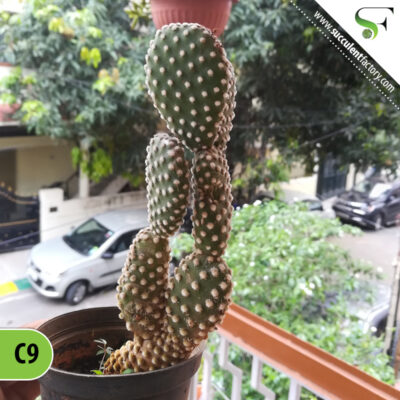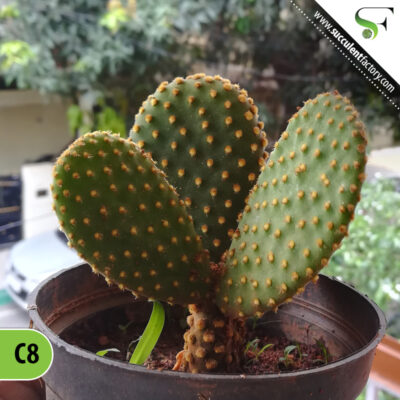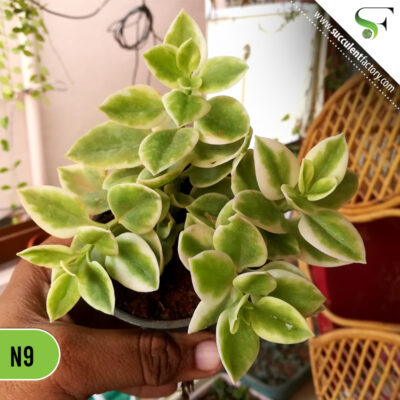-
Sale!

₹200.00 Original price was: ₹200.00.₹149.00Current price is: ₹149.00.
Aloe Christmas Carol: A Festive Succulent Delight
The Aloe Christmas Carol is a charming succulent that brings a touch of holiday cheer to any space year-round. Here’s a more detailed look at this festive plant and how to keep it thriving:
Description:
- Leaves:
- Color: The star of the show! Deep green leaves boast vibrant red borders, creating a striking contrast and earning its festive name.
- Shape: The leaves are thick and fleshy, forming a rosette pattern that resembles a star when viewed from above.
- Texture: The leaves may have a slightly rough or bumpy texture, adding to their visual interest.
- Size: This succulent is on the smaller side, typically reaching a mature height of around 1 foot (30 cm) with a similar spread. Indoors, it will likely be even more compact.
ALL THE PLANTS WILL BE SENT BARE ROOTED. NO SOIL NO POT
-
Sale!

₹199.00 Original price was: ₹199.00.₹149.00Current price is: ₹149.00.
Bergeranthus, also sometimes known as “Flowering Ice Plant”, is a genus of succulent plants native to South Africa. They are prized for their attractive, fleshy foliage and vibrant daisy-like flowers. Here’s a breakdown of what you need to know about Bergeranthus:
Description:
- Leaves: These come in a variety of shapes depending on the species, but are most commonly plump and fleshy. Colors can range from green to grey-green, and some varieties may have a waxy coating.
- Flowers: The star of the show! Bergeranthus produces beautiful daisy-like flowers in a range of colors including pink, purple, yellow, and white. These typically bloom in spring and summer, adding a delightful pop of color to the succulent’s appearance.
- Size: Bergeranthus species vary in size, with some forming compact clumps reaching only a few inches tall, while others can grow into trailing plants reaching up to 2 feet in length.
ALL THE PLANTS WILL BE SENT BARE ROOTED. NO SOIL NO POT
-
Sale!

₹200.00 Original price was: ₹200.00.₹149.00Current price is: ₹149.00.
The Dyckia brevifolia, also known as the sawblade, is a species of flowering plant in the Bromeliaceae family. This succulent is endemic to Brazil.
Description:
- Leaves: This is the star feature! The Dyckia brevifolia boasts thick, fleshy, and spoon-shaped leaves that are unlike most Echeverias. Instead of growing flat or cupped upwards, the leaves curve downwards and inwards along the central stem, creating a cascading, upside-down V shape. The color can vary from a silvery-blue to a soft green, and the leaves may have a dusty waxy coating (farina) that helps protect them from sun and excessive water loss.
- Size: This succulent typically grows to a compact or cascading size, reaching 6 to 8 inches (15-20 cm) tall and spreading wider as the leaves drape over the pot.
- Flowers: During summer or fall, the plant might produce clusters of orange or yellow bell-shaped flowers on tall stalks, adding a touch of contrast to its unique foliage.
ALL THE PLANTS WILL BE SENT BARE ROOTED. NO SOIL NO POT
-
Sale!

₹200.00 Original price was: ₹200.00.₹149.00Current price is: ₹149.00.
he Echeveria ‘Coccinea’, also known as the Red Echeveria, is a stunning succulent prized for its vibrant coloring and ease of care. Here’s a breakdown of its characteristics and how to keep it flourishing:
Description:
- Leaves: Echeveria ‘Coccinea’ boasts thick, fleshy, and oval-shaped leaves that form a rosette pattern. These leaves are a captivating reddish-orange color, intensifying in sunlight.
- Size: This succulent typically grows to a compact size, around 6 to 12 inches (15-30 cm) tall and wide.
- Flowers: During spring or summer, the plant might produce clusters of orange-red, bell-shaped flowers on tall stalks, adding a touch of elegance to its beauty.
ALL THE PLANTS WILL BE SENT BARE ROOTED. NO SOIL NO POT
-
Sale!

₹200.00 Original price was: ₹200.00.₹149.00Current price is: ₹149.00.
The Echeveria Elegans, also known as the Mexican Snowball, Hen and Chicks, Mexican Ghost Plant, or White Mexican Rose, is a beautiful and award-winning succulent prized for its elegant form, cascading rosettes, and delicate flowers. Here’s a breakdown of its characteristics and how to keep it flourishing:
Description:
- Leaves: Echeveria Elegans boasts thick, fleshy, and spoon-shaped leaves that form rosettes around a central stem. These rosettes can grow up to 4 inches (10 cm) in diameter. The leaves are a captivating pale silvery-green to light blue-green color, with a slight waxy coating that gives them a frosted appearance.
- Size: This succulent can grow up to 12 inches (30 cm) tall and wide, with a mature plant forming a cluster of cascading rosettes. The offsets (pups) that grow around the base contribute to its dense and impressive form.
- Flowers: During late winter and spring, the plant sends up tall, pink-red stalks that reach up to 1 foot (30 cm) in height. These stalks boast clusters of lantern-shaped, pink flowers with yellow tips, adding a touch of elegance and contrasting beautifully with the silvery-green foliage.
ALL THE PLANTS WILL BE SENT BARE ROOTED. NO SOIL NO POT
-
Sale!

₹200.00 Original price was: ₹200.00.₹149.00Current price is: ₹149.00.
The Echeveria runyonii ‘Topsy Turvy’, also known as the Donkey’s Tail Echeveria or simply Topsy Turvy, is a unique and eye-catching succulent prized for its unusual appearance and easy care requirements. Here’s a closer look at this quirky succulent:
Description:
- Leaves: This is the star feature! The Topsy Turvy boasts thick, fleshy, and spoon-shaped leaves that are unlike most Echeverias. Instead of growing flat or cupped upwards, the leaves curve downwards and inwards along the central stem, creating a cascading, upside-down V shape. The color can vary from a silvery-blue to a soft green, and the leaves may have a dusty waxy coating (farina) that helps protect them from sun and excessive water loss.
- Size: This succulent typically grows to a compact or cascading size, reaching 6 to 8 inches (15-20 cm) tall and spreading wider as the leaves drape over the pot.
- Flowers: During summer or fall, the plant might produce clusters of orange or yellow bell-shaped flowers on tall stalks, adding a touch of contrast to its unique foliage.
ALL THE PLANTS WILL BE SENT BARE ROOTED. NO SOIL NO POT
-
Sale!

₹200.00 Original price was: ₹200.00.₹149.00Current price is: ₹149.00.
The Echeveria Runyonii Cristata, also known as the Topsy Turvy Cristata or Crested Donkey’s Tail, is a truly unique and stunning succulent variety prized for its unusual crested growth and cascading, spoon-shaped leaves. Here’s a breakdown of its characteristics and how to keep it thriving:
Description:
-
Leaves: This is where the magic happens! Unlike regular Echeveria Runyonii, the Cristata form develops a flattened and “crested” growth pattern on the central stem. Individual leaves become fused together, creating a wavy, rippled effect along the edges. The leaves themselves are typically a silvery-blue to soft green color and may have a dusty waxy coating (farina). They retain the characteristic spoon-shaped form and curve downwards and inwards, cascading over the pot like the regular Topsy Turvy.
-
Size: Echeveria Runyonii Cristata grows similarly to the regular variety, reaching a compact or cascading size of 6 to 8 inches (15-20 cm) tall and spreading wider as the leaves drape over the edges of the pot.
-
Flowers: During summer or fall, the plant might produce clusters of orange or yellow bell-shaped flowers on tall stalks, adding a touch of contrast to the unique crested foliage. However, flowering is less frequent compared to the regular Echeveria Runyonii.
ALL THE PLANTS WILL BE SENT BARE ROOTED. NO SOIL NO POT
-
Sale!

₹200.00 Original price was: ₹200.00.₹149.00Current price is: ₹149.00.
The Ficus Microcarpa, also commonly known as the Indian Laurel, Chinese Banyan, Malayan Banyan, Curtain Fig, or Gajumaru, is a beautiful tree native to tropical regions of Southeast Asia and Australia. It is a popular choice for bonsai enthusiasts and can also be grown as a houseplant or outdoor tree.
- Leaves: The Ficus Microcarpa has glossy, dark green leaves that are elliptical or oval-shaped. They can grow up to 2-3 inches (5-8 cm) long.
- Bark: The bark of the tree is smooth and light gray. As the tree matures, it develops aerial roots that grow down from the branches and eventually reach the ground. These roots can thicken and become a characteristic feature of the tree.
- Size: In its natural habitat, the Ficus Microcarpa can grow up to 100 feet (30 meters) tall. However, when grown as a houseplant, it will typically only reach a height of 6-10 feet (1.8-3 meters).
ALL THE PLANTS WILL BE SENT BARE ROOTED. NO SOIL NO POT
-
Sale!

₹199.00 Original price was: ₹199.00.₹149.00Current price is: ₹149.00.
-
Sale!

₹200.00 Original price was: ₹200.00.₹149.00Current price is: ₹149.00.
Haworthia limifolia, formerly known as Haworthia limifolia but now reclassified as Haworthia limifolia (asterisk denotes a transferred name), is a charming and easy-to-care-for succulent prized for its unique appearance and compact size. Here’s a closer look at this little gem:
Description:
- Leaves:
- Shape: Haworthia limifolia boasts triangular, fleshy leaves that form a tight rosette around a central stem.
- Color: The leaves are typically a light to dark green, sometimes with a brownish tinge.
- Texture: The leaves have a smooth, translucent quality and are adorned with raised tubercles along the edges, giving them a textured and almost washboard-like appearance. This is where the common name “Fairy Washboard” originates.
- Size: This succulent is known for its compact size, typically reaching only 4 inches (10 cm) in diameter and 1-2 inches (2.5-5 cm) in height. It forms clumps over time, creating a delightful cluster of rosettes.
ALL THE PLANTS WILL BE SENT BARE ROOTED. NO SOIL NO POT
-
Sale!

₹200.00 Original price was: ₹200.00.₹149.00Current price is: ₹149.00.
The Kalanchoe longiflora, also known as the Tugela Cliff Kalanchoe or Long-Flowered Kalanchoe, is a unique and somewhat obscure succulent native to South Africa. Here’s a breakdown of its characteristics and how to care for it:
Description:
- Leaves:
- Color: Grey-green with a waxy bloom, often with pinkish or reddish margins, or completely reddish-brown on some varieties.
- Shape: These are oblong or spoon-shaped with a sharp or rounded tip and can be up to 3.2 inches (8 cm) long.
- Arrangement: The leaves grow on 4-angled, decumbent branches that can reach up to 16 inches (40 cm) long.
- Flowers: Unlike many succulents, Kalanchoe longiflora produces clusters of yellow, tubular flowers in autumn and winter. These flowers add a pop of color during the cooler months.
ALL THE PLANTS WILL BE SENT BARE ROOTED. NO SOIL NO POT
-
Sale!

₹300.00 Original price was: ₹300.00.₹149.00Current price is: ₹149.00.
Opuntia, commonly known as the prickly pear cactus, is a genus of cacti native to North and South America. They are known for their flat, paddle-shaped pads covered in spines and glochids (tiny barbed hairs). Opuntias come in a wide variety of shapes, sizes, and colors, making them popular choices for both indoor and outdoor gardens.
Here’s a closer look at Opuntia cactus and how to care for them:
Description:
- Pads: The most distinctive feature of Opuntia is its flattened pads, also known as stems or cladodes. These pads can be oval, circular, or oblong, depending on the species. The size of the pads can also vary greatly, ranging from just a few inches to several feet in length.
- Spines: Most Opuntia species have spines, which are sharp outgrowths from the pads. Spines can help to protect the cactus from predators and herbivores.
- Glochids: In addition to spines, many Opuntia species also have glochids. Glochids are tiny barbed hairs that can easily detach from the cactus and become lodged in skin or fur. They can be very irritating, so it is important to handle Opuntia with care.
- Flowers: Opuntia cacti produce flowers in a variety of colors, including yellow, orange, red, and purple. The flowers are typically large and showy, and they can bloom in spring, summer, or fall.
- Fruit: After flowering, Opuntia cacti produce fruit, which is known as a prickly pear. The fruit can be eaten, and it is a good source of vitamin C and fiber.
ALL THE PLANTS WILL BE SENT BARE ROOTED. NO SOIL NO POT
-
Sale!

₹300.00 Original price was: ₹300.00.₹149.00Current price is: ₹149.00.
Opuntia, commonly known as the prickly pear cactus, is a genus of cacti native to North and South America. They are known for their flat, paddle-shaped pads covered in spines and glochids (tiny barbed hairs). Opuntias come in a wide variety of shapes, sizes, and colors, making them popular choices for both indoor and outdoor gardens.
Here’s a closer look at Opuntia cactus and how to care for them:
Description:
- Pads: The most distinctive feature of Opuntia is its flattened pads, also known as stems or cladodes. These pads can be oval, circular, or oblong, depending on the species. The size of the pads can also vary greatly, ranging from just a few inches to several feet in length.
- Spines: Most Opuntia species have spines, which are sharp outgrowths from the pads. Spines can help to protect the cactus from predators and herbivores.
- Glochids: In addition to spines, many Opuntia species also have glochids. Glochids are tiny barbed hairs that can easily detach from the cactus and become lodged in skin or fur. They can be very irritating, so it is important to handle Opuntia with care.
- Flowers: Opuntia cacti produce flowers in a variety of colors, including yellow, orange, red, and purple. The flowers are typically large and showy, and they can bloom in spring, summer, or fall.
- Fruit: After flowering, Opuntia cacti produce fruit, which is known as a prickly pear. The fruit can be eaten, and it is a good source of vitamin C and fiber.
ALL THE PLANTS WILL BE SENT BARE ROOTED. NO SOIL NO POT
-
Sale!

₹300.00 Original price was: ₹300.00.₹149.00Current price is: ₹149.00.
Opuntia, commonly known as the prickly pear cactus, is a genus of cacti native to North and South America. They are known for their flat, paddle-shaped pads covered in spines and glochids (tiny barbed hairs). Opuntias come in a wide variety of shapes, sizes, and colors, making them popular choices for both indoor and outdoor gardens.
Here’s a closer look at Opuntia cactus and how to care for them:
Description:
- Pads: The most distinctive feature of Opuntia is its flattened pads, also known as stems or cladodes. These pads can be oval, circular, or oblong, depending on the species. The size of the pads can also vary greatly, ranging from just a few inches to several feet in length.
- Spines: Most Opuntia species have spines, which are sharp outgrowths from the pads. Spines can help to protect the cactus from predators and herbivores.
- Glochids: In addition to spines, many Opuntia species also have glochids. Glochids are tiny barbed hairs that can easily detach from the cactus and become lodged in skin or fur. They can be very irritating, so it is important to handle Opuntia with care.
- Flowers: Opuntia cacti produce flowers in a variety of colors, including yellow, orange, red, and purple. The flowers are typically large and showy, and they can bloom in spring, summer, or fall.
- Fruit: After flowering, Opuntia cacti produce fruit, which is known as a prickly pear. The fruit can be eaten, and it is a good source of vitamin C and fiber.
ALL THE PLANTS WILL BE SENT BARE ROOTED. NO SOIL NO POT
-
Sale!

₹200.00 Original price was: ₹200.00.₹149.00Current price is: ₹149.00.
Sedum Rubrotinctum Aurora, also commonly known as Pink Jelly Bean Sedum or Aurora Borealis Sedum, is a captivating succulent prized for its plump, jelly bean-like leaves and attractive pink coloration. Here’s a breakdown of its characteristics and how to keep it flourishing:
Description:
- Leaves: The star attraction! These are small, round, and fleshy, resembling plump jelly beans. The color is a captivating light to intense pink, especially when exposed to bright light or drought conditions. In shadier areas or with overwatering, they may appear pale green or white.
- Size: Sedum Rubrotinctum Aurora is a low-growing succulent, typically forming a dense mat that reaches 2-3 inches (5-8 cm) tall and can spread up to 12 inches (30 cm) wide.
- Flowers: Inconspicuous greenish-white or yellow flowers may appear occasionally during summer, but the foliage is the main attraction.
-
Sale!

₹200.00 Original price was: ₹200.00.₹149.00Current price is: ₹149.00.
Variegated Aptenia cordifolia, also commonly known as the Variegated Heartleaf Ice Plant or Red Apple, is a beautiful succulent plant prized for its cascading trails, vibrant flowers, and variegated foliage.
Here’s a breakdown of its characteristics and how to keep it thriving:
Description:
- Leaves: The most striking feature of this succulent is its bi-colored foliage. It boasts bright green, heart-shaped leaves edged in creamy white or yellow, creating a variegated effect. The leaves are fleshy and glossy, adding to the plant’s charm.
- Flowers: During spring and summer, the plant produces a profusion of small, bright pink or purplish daisy-like flowers. These blooms add a delightful pop of color and attract pollinators like butterflies and bees.
- Size: Variegated Aptenia cordifolia is a trailing succulent that typically grows to 6 inches (15 cm) tall and can spread up to 2 feet (60 cm) wide. Its cascading stems make it ideal for hanging baskets or containers where it can drape over the edges.
ALL THE PLANTS WILL BE SENT BARE ROOTED. NO SOIL NO POT
















